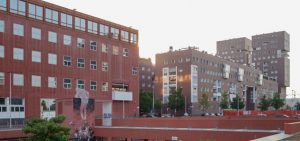Department of Economics Management and Statistics
 In the Marketing Cluster (Department of Economics Management and Statistics) a research line was developed to analyze the contemporary art and design market and the relationships between cultural industries.
In the Marketing Cluster (Department of Economics Management and Statistics) a research line was developed to analyze the contemporary art and design market and the relationships between cultural industries.
The ARG (Art & Culture Research Group) was born as an experimental model to attract the resources, interests and research goals in the Milano-Bicocca University related to art and cultural heritage economy. The group, integrating with the B-ASC group, develops theoretical and applied research projects on the correlation between art, culture and economy, based on the multidisciplinary logic that involves Marketing & Management, Economy and business management, Statistics, Tourism economy, Cultural Heritage Economy and Cultural Heritage Law.
Francesca Capo followed a research project focused on the Farm Cultural Park enterprise (https://www.farmculturalpark.com/), a project based in Favara (Agrigento) that integrates culture and education as tools to foster urban regeneration, create economic value in the area, and promote empowerment and community engagement. The research project resulted in the following publication: Capo, F., Vaccaro, A., & Berrone, P. (2023). *Revitalizing urban places: How prosocial organizations acquire saliency in the eyes of resisting stakeholders*. Journal of Business Ethics, 1-21.
Federica Codignola is currently working on research about collectible design as a category within the art market and is analyzing the concept of 'sustainability' in relation to the art market. Regarding the first research, at the conference “ASA2024, Measuring and Interpreting World Changes with Statistics, Data Science and AI” (Sapienza University of Rome, 18-20 September 2024), she presented the paper: Benedan, L., Codignola, F., Galeone, C., Mariani, P., *Exploring Art Market Trends: A Delphi Study on Collectible Design*. Together with Professor Paolo Mariani, in 2022, she also published an article on the topic of art consumption concerning the collecting patterns observed in the case study of François Pinault's private art collection: *Investigating preferences in art collecting: the case of the François Pinault Collection*, Italian Journal of Marketing, Springer, vol. 2022(1), March.
Since January 2022, Silvia Marchesi has been an Associate Editor at the Journal of Cultural Economics. Among her publications are: *Liberalizing Art: Evidence on the Impressionists at the end of the Paris Salon* (with Federico Etro and Elena Stepanova), 2020, European Journal of Political Economy, 62, 101-120; *The Labor Market in the Art Sector of Baroque Rome* (with Federico Etro and Laura Pagani), 2015, Economic Inquiry 53: 365-387; *Gli affari dei pittori nell'Italia del Barocco* (with Laura Pagani), 2013, Vita e Pensiero 1: 135-142. She also recently presented the following project on art markets: COST Action Proposal OC-2020-1-24942 *"ART markets: emergence, TRAnsformation and DEcline"*.
Riccardo Viale and his team worked on the valorization from a behavioural perspective of the Roman heritage in Morocco for the FCA (Fondazione Cultura ed Arte) of Rome. The project was based on an empirical study of human perceptual, cognitive, and affective variables that influence the visitor's attention and inclination toward the enjoyment of cultural heritage—specifically the Roman site of Chellah in Rabat. What did the behavioural analysis of the visitor-cultural heritage interaction reveal? In short, it highlighted the following elements of this interaction: a) Differentiated perceptual relevance of the components of the cultural asset; b) Affective and emotional dimension towards the asset as it is currently and as it could become through its enhancement; c) Mental representation of the asset and the ability (or inability) to understand and describe it; d) WTP (Willingness to Pay) for the asset and its parts to understand the value attributed to it; e) Nudge techniques aimed at promoting the attractiveness and enjoyment of the cultural asset.
